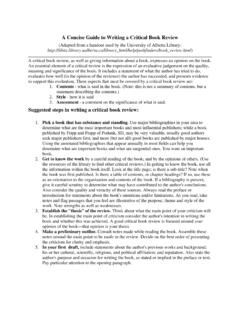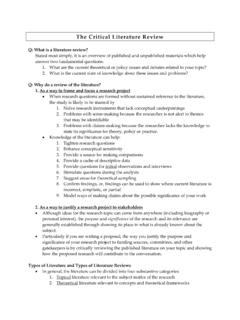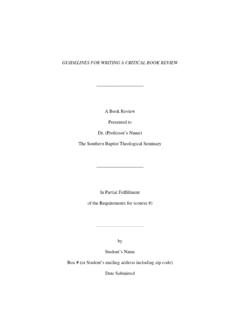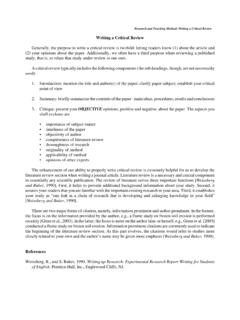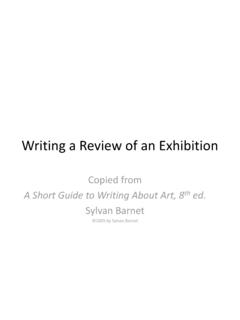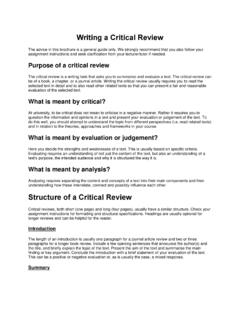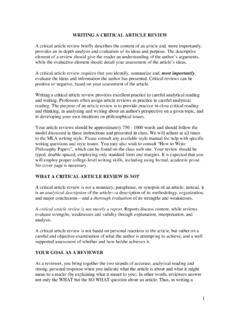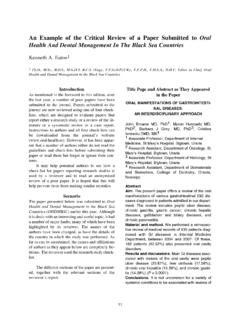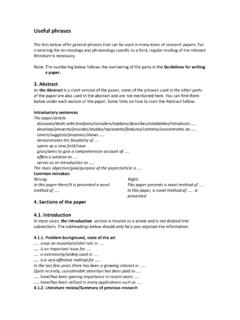Transcription of Writing a Critical Review - Nazarene Theological College
1 Writing a Critical ReviewA Critical Review is an academic appraisal of a text that offers both a summary and Critical comment on the content. This makes it different to a literature Review , which examines a body of literature or series of key academic articles addressing a specific topic of interest. Purpose of a Critical ReviewThe Critical Review is a Writing task that asks you to summarise and evaluate a text. The Critical Review can be of a book, a chapter, or a journal article. Writing the Critical Review requires you to read the selected text in detail and also to read other related texts so that you can present a fair and reasonable evaluation of the selected text.
2 Writing a Critical Review helps you to: analyse the text and evaluate its relevance to your academic needs; and analyse, describe and interpret a text to show your understanding of what you have order to write a Critical Review , you have to be able to read and think critically. They help you to: Remain informed about issues relevant to your field of study; Evaluate the material offered by others; Generate alternative is Critical in the sense that it: is a thoughtful consideration of the validity and accuracy of the author's claims; considers the benefits and limitations of the author's point of view; identifies other valid points of is meant by Critical ?
3 A Critical Review is not just a summary. It is an evaluation of what an author has said about a College level, to be Critical does not mean to criticise in a negative manner. Rather it requires you to question the information and opinions in a text and present your evaluation or judgement of the text. To do this well, you should attempt to understand the topic from different perspectives ( read related texts) and in relation to the theories, approaches and frameworks in your course. What is meant by evaluation or judgement?Here you decide the strengths and weaknesses of a text.
4 This is usually based on specific criteria. Evaluating requires an understanding of not just the content of the text, but also an understanding of a text s purpose, the intended audience and why it is structured the way it is meant by analysis?Analysing requires separating the content and concepts of a text into their main components and then understanding how these interrelate, connect and possibly influence each critically on an article involves analysis and evaluation. Analysis of the article involves dissecting the information presented in order to identify the purpose, the main points, the methodology and the findings or conclusions of the article (This is done in the initial summarising step).
5 In addition, analysis for Critical comment involves identifying:1. unstated assumptions2. steps in the argument that are not logical3. any additional purposes of the article that are not explicitly of the article involves making judgments about the value (both positive and negative) ofthe article against specific of a Critical ReviewHeadings are usually optional for longer reviews and can be helpful for the length of an introduction is usually one paragraph for a journal article Review and two or three paragraphs for a longer book Review .
6 Include a few opening sentences that announce the author(s) and the title, and briefly explain the topic of the text. Present the aim of the text and summarise the main finding or key argument. Conclude the introduction with a brief statement of your evaluation of the text. This can be a positive or negative evaluation or, as is usually the case, a mixed response. SummaryPresent a summary of the key points along with a limited number of examples. You can also briefly explain the author s purpose/intentions throughout the text and you may briefly describe how the text is organised.
7 The summary should not be more than a third of the Critical Review . CritiqueThe critique should be a balanced discussion and evaluation of the strengths, weakness and notable features of the text. Remember to base your discussion on specific criteria. Good reviews also include other sources to support your evaluation (remember to reference). You can choose how to sequence your critique. Here are some examples to get you started: Most important to least important conclusions you make about the text. If your critique is more positive than negative, then present the negative points first and the positive last.
8 If your critique is more negative than positive, then present the positive points first and the negative last. If there are both strengths and weakness for each criterion you use, you need to decide overall what your judgement is. For example, you may want to comment on a key idea in the text and have both positive and negative comments. You could begin by stating what is good about the idea and then concede and explain how it is limited in some way. While this example shows a mixed evaluation, overall you are probably being more negative than positive.
9 In long reviews, you can address each criteria you choose in a paragraph, including both negative and positive points. For very short Critical reviews (one page or less) where your comments will be briefer, include a paragraph of positive aspects and another of negative. You can also include recommendations for how the text can be improved in terms of ideas, research approach; theories or frameworks used can also be included in the critique is usually a very short paragraph. Restate your overall opinion of the text. Briefly present recommendations.
10 If necessary some further qualification or explanation of your judgement can be included. This can help your critique sound fair and you have used other sources in you Review you should also include a list of references at the end of the and paraphrasing for the Critical reviewSummarising and paraphrasing are essential skills for academic Writing and in particular, the Critical Review . To summarise means to reduce a text to its main points and its most important ideas. The length of your summary for a Critical Review should only be about one quarter to one third of the whole Critical Review .
